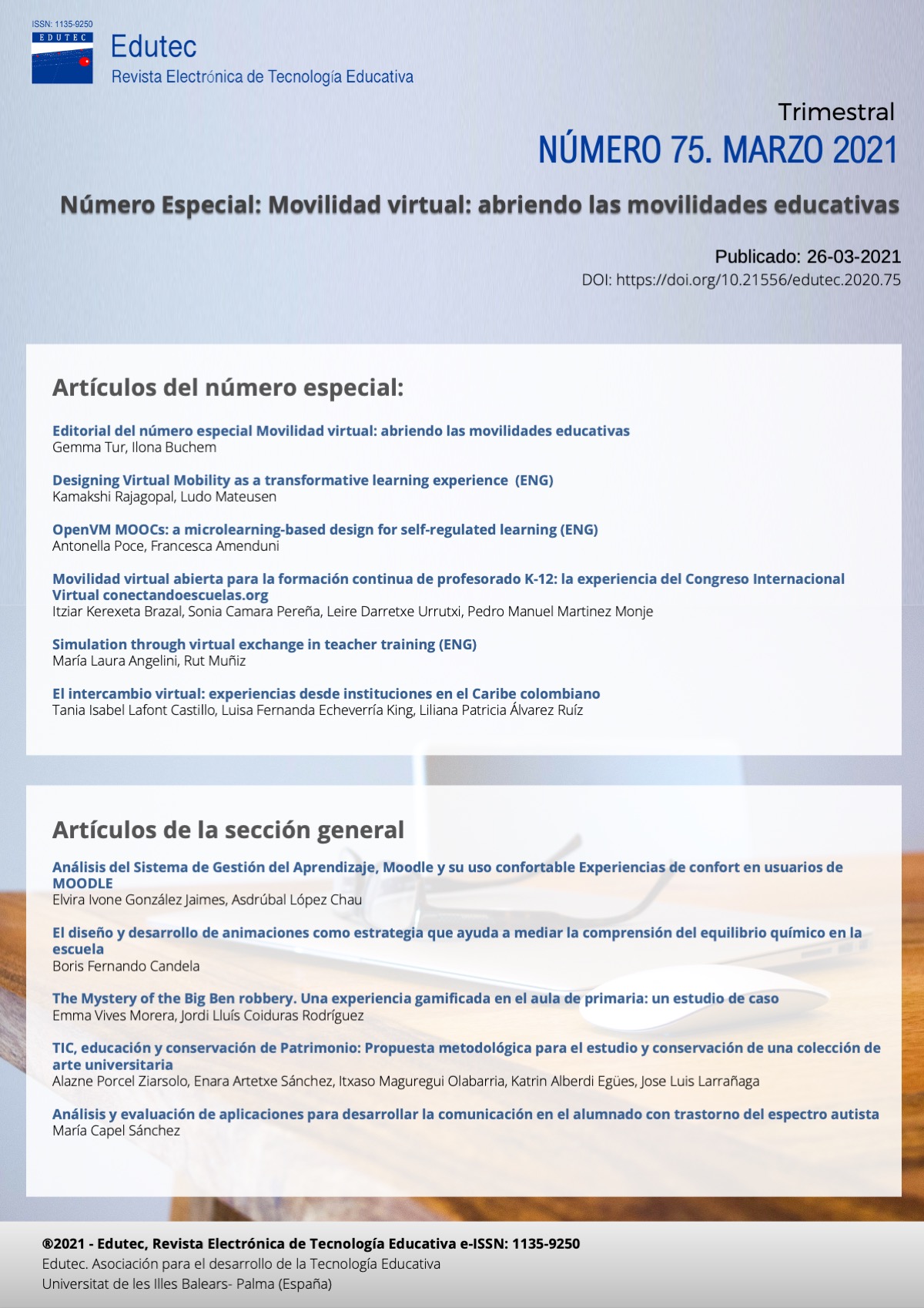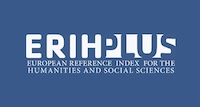Diseñando la Movilidad virtual como una experiencia de aprendizaje transformadora
DOI:
https://doi.org/10.21556/edutec.2021.75.1953Palabras clave:
Movilidad virtual, intercambio virtual, relfexión crítica, aprendizaje transformador, ACADResumen
La movilidad virtual y la movilidad híbrida del alumnado se están convirtiendo en un área estratégica clave de la política educativa europea, con el objetivo de proporcionar a todo el alumnado de Europa la experiencia de la movilidad durante sus estudios. Este artículo examina en qué medida estas formas de movilidad están diseñadas para apoyar experiencias de aprendizaje transformadoras, a través del análisis de tres casos de movilidad virtual en la educación secundaria y tres casos en la educación superior, utilizando el Marco de Análisis y Diseño Centrado en la Actividad (ACAD). Los resultados muestran que la movilidad virtual ofrece entornos de aprendizaje adecuados en los que puede producirse un aprendizaje transformador. Sin embargo, la reflexión estructurada debe diseñarse de forma más elaborada y recibir más apoyo para alcanzar todo su potencial. El artículo sugiere que la reflexión estructurada se centra actualmente en el desarrollo de habilidades y actitudes interculturales, pero ofrece oportunidades para otras habilidades del alumno en la movilidad virtual (como aprendizaje colaborativo y el aprendizaje en red). El artículo sugiere algunos métodos para ello.
Descargas
Citas
Anson, C. M. (1997). On reflection: The role of logs and journals in service-learning courses. Writing the community: Concepts and models for service-learning in composition, 167-180.
Baiutti, M. (2018). Fostering assessment of student mobility in secondary schools: indicators of intercultural competence. Intercultural Education, 29(5–6), 549–570. https://doi.org/10.1080/14675986.2018.1495318
Bandura, A. (1997). Self-efficacy: the exercise of control. New York: W.H. Freeman. DOI: https://doi.org/10.21556/edutec.2021.77.2177
Barton, G., & Ryan, M. (2020). What Does Reflection Look and Feel Like for International Students? An Exploration of Reflective Thinking, Reflexivity and Employability. Journal of International Students, 10(S2), 1–16. https://doi.org/10.32674/jis.v10iS2.2848
Blaschke, L. M., & Marín, V. I. (2020). Applications of heutagogy in the educational use of e-portfolios. Revista de Educacion a Distancia, 20(64). https://doi.org/10.6018/RED.407831
Boud, D., Keogh, R., & Walker, D. (1996). Promoting reflection in learning: A model. In R. Edwards, A. Hanson & P. Raggatt (Eds.), Boundaries of adult learning (pp.32-56). Routledge.
Brown, J. S., Collins, A., & Duguid, P. (1989). Situated cognition and the culture of learning. Institute for Inquim, 18(1), 32–42. https://doi.org/10.3102/0013189X018001032
Carvalho, L., & Goodyear, P. (2018). Design, learning networks and service innovation. Design Studies, 55, 27–53. https://doi.org/10.1016/j.destud.2017.09.003 DOI: https://doi.org/10.14393/ER-v28a2021-11
Chwialkowska, A. (2020). Maximizing Cross-Cultural Learning From Exchange Study Abroad Programs: Transformative Learning Theory. Journal of Studies in International Education, https://doi.org/10.1177/1028315320906163
Ceo-DiFrancesco, D., Dunn, L. S., & Solorio, N. (2020). Transforming Through Reflection: Use of Student-Led Reflections in the Development of Intercultural Competence during a Short-Term International Immersion Experience. Internet Journal of Allied Health Sciences and Practice, 18(2), 8. https://nsuworks.nova.edu/ijahsp/vol18/iss2/8/
Deardorff, D. K. (2006). Identification and assessment of intercultural competence as a student outcome of internationalization. Journal of Studies in International Education, 10(3), 241–266. https://doi.org/10.1177/1028315306287002 DOI: https://doi.org/10.1111/tops.12192
Deardorff, D. K. (2020). Manual for developing intercultural competencies. Story circles. Unesco Publishing and Routledge. https://doi.org/10.4324/9780429244612-2 DOI: https://doi.org/10.1037/dev0000884
De Wit, H. (2016) Internationalisation and the role of online intercultural exchange. In R. O'Dowd & T. Lewis (Eds.). Online Intercultural Exchange: Policy, pedagogy, practice. Routledge. DOI: https://doi.org/10.1145/2696454.2696468
Duffy, L. N., Stone, G. A., Townsend, J., & Cathey, J. (2020). Rethinking Curriculum Internationalization: Virtual Exchange as a Means to Attaining Global Competencies, Developing Critical Thinking, and Experiencing Transformative Learning. SCHOLE: A Journal of Leisure Studies and Recreation Education, 0(0), 1–15. https://doi.org/10.1080/1937156x.2020.1760749 DOI: https://doi.org/10.1155/2022/3813820
Erasmus+ (2020). Erasmus+ Programme Guide. European Commission. https://ec.europa.eu/programmes/erasmus-plus/resources/documents/erasmus-programme-guide-2020_en DOI: https://doi.org/10.1007/978-3-319-40379-3_4
eTwinning (2021). eTwinning. https://www.etwinning.net/en/pub/index.htm DOI: https://doi.org/10.1177/1687814017698663
European Commission (2021a). Mobility and cooperation. https://ec.europa.eu/education/policies/higher-education/mobility-and-cooperation_en#:~:text=Learning%20mobility%20is%20an%20opportunity,to%20study%20or%20undertake%20training.&text=for%20mobility%20experiences.-,European%20ministers%20have%20agreed%20to%20double%20the%20proportion%20of%20students,to%2020%20percent%20by%202020. DOI: https://doi.org/10.3389/fpsyg.2018.00468
European Commission (2021b). Interactive facts and stats on Erasmus+. https://ec.europa.eu/programmes/erasmus-plus/news/interactive-facts-and-stats-erasmus_en DOI: https://doi.org/10.4337/9781783476732.00017
European Commission (2021c). Erasmus+ Virtual Exchange – Intercultural Learning Experiences. https://europa.eu/youth/sites/default/files/eyp/eve/attachments/eve_brochure_2019.pdf DOI: https://doi.org/10.3389/fpsyg.2020.00469
Evolve (2021) What is Virtual Exchange? https://evolve-erasmus.eu/about-evolve/what-is-virtual-exchange/ DOI: https://doi.org/10.1145/3202185.3202741
Fleming, T. (2014). Axel Honneth and the Struggle for Recognition: Implications for Transformative Learning. Proceedings of the XI International Transformative Learning Conference, (December), 318–324. DOI: https://doi.org/10.1111/cogs.13043
Fleming, T. (2018). Critical Theory and Transformative Learning: Rethinking the Radical Intent of Mezirow's Theory. International Journal of Adult Vocational Education and Technology, 9(3), 1-13. IGI Global. https://www-learntechlib-org.kuleuven.ezproxy.kuleuven.be/p/186256/. DOI: https://doi.org/10.23923/pap.psicol.2996
Frydenberg, Mark, & Andone, Diana. (2018). Enhancing and Transforming Global Learning Communities with Augmented Reality. Journal of Information Systems Education, 29(1), 37-44. https://aisel.aisnet.org/jise/vol29/iss1/10 DOI: https://doi.org/10.1145/3469595.3469604
Frydenberg, M. & Andone, D. (2019). Does Creating Shared Projects in Virtual Reality Capture Students' Interest in Technology? An International Project in STEM Education. 2019 IEEE Integrated STEM Education Conference (ISEC), 311-315. DOI: https://doi.org/10.1007/s11528-015-0835-0
Gehrke, N. J., Knapp, M. S., & Sirotnik, K. A. (1992). In Search of the School Curriculum. Review of Research in Education, 18(1), 51–110. https://doi.org/10.3102/0091732X018001051 DOI: https://doi.org/10.1207/s15327051hci1901&2_4
Glassner, A., & Back, S. (2020). Exploring heutagogy in higher education: Academia meets the Zeitgeist. Springer Nature. DOI: https://doi.org/10.1145/3171221.3171266
Goodyear, P., & Carvalho, L. (2019). The analysis of complex learning environments. In H. Beetham & R. Sharpe (Eds.) Rethinking pedagogy for a digital age: Principles and practices of design (pp. 49-65). Routledge. DOI: https://doi.org/10.1145/2696454.2696457
Goodyear, P., Carvalho, L., & Yeoman, P. (2021). Activity-Centred Analysis and Design (ACAD): Core purposes, distinctive qualities and current developments. Educational Technology Research and Development, (0123456789). https://doi.org/10.1007/s11423-020-09926-7 DOI: https://doi.org/10.1371/journal.pone.0216869
Hase, S., & Kenyon C. (2000). From andragogy to heutagogy. ultiBASE, 5 (3). Online Journal. http://pandora.nla.gov.au/nnh-wb/2001022013OO00/http://ultibase.rmit.edu.au/Articles/decQ0/hase2.htm. DOI: https://doi.org/10.1007/978-3-319-25554-5_39
IEREST (2015) Intercultural Education Resources for Erasmus Students and their Teachers, Koper: Annales University Press. DOI: https://doi.org/10.1016/j.chb.2019.09.025
Kidwai, K., Johnson, G., Hsieh, P., Hu, R., & Buzzetto-More, N. (2010). Promoting reflective thinking through e-portfolios. In N. A. Buzzetto-More (Ed.) The e-portfolio paradigm: Informing, educating, assessing, and managing with e-portfolios. (pp.247-266). Informing Science Press. DOI: https://doi.org/10.1111/j.1540-4560.2009.01613.x
Kitchenham, A. (2008). The evolution of John Mezirow's transformative learning theory. Journal of Transformative Education, Vol. 6, pp. 104–123. https://doi.org/10.1177/1541344608322678 DOI: https://doi.org/10.1145/2701973.2701977
McKenney, S., & Reeves, T. C. (2018). Conducting educational design research. Routledge. DOI: https://doi.org/10.1016/j.cogdev.2021.101044
Mezirow, J. (1997). Transformative learning: Theory to practice. New directions for adult and continuing education, 1997(74), 5-12. https://doi.org/10.1002/ace.7401 DOI: https://doi.org/10.1016/j.jecp.2015.05.009
Nada, C. I., Montgomery, C., & Araújo, H. C. (2018). 'You went to Europe and returned different': Transformative learning experiences of international students in Portugal. European Educational Research Journal, 17(5), 696–713. https://doi.org/10.1177/1474904118765334 DOI: https://doi.org/10.1016/j.cogdev.2020.100875
Op de Beeck, I., Bijnens, K. & Van Petegem, W. (2008). Home and Away: Coaching Exchange Students from a Distance. Europace. Heverlee, Belgium. https://www.kuleuven.be/onderwijs/werken_opo/documenten/vm-base-blended-mobility-manual.pdf DOI: https://doi.org/10.1145/2701973.2702058
Rajagopal, K., Firssova, O., de Beeck, I. O., Van der Stappen, E., Stoyanov, S., Henderikx, P., & Buchem, I. (2020). Learner skills in open virtual mobility. Research in Learning Technology, 28. http://dx.doi.org/10.25304/rlt.v28.2254 DOI: https://doi.org/10.1109/ROMAN.2014.6926313
Rajagopal, K. & Firssova, O. (2020). Open VM Final Report on Conceptual Guidelines. https://www.openvirtualmobility.eu/topics/outputs/o1-framework-and-guidelines/ DOI: https://doi.org/10.1016/j.jecp.2019.06.009
Remillard, J. T. (2005). Examining key concepts in research on teachers' use of mathematics curricula. Review of Educational Research, 75(2), 211–246. https://doi.org/10.3102/00346543075002211
Rintala, U. (2011). State-of-the-art in support of virtual placements – A study carried out in the framework of the EU-VIP project. https://www.eurashe.eu/library/modernising-phe/mobility/virtual/WG4%20R%20euvip%20annex11.pdf DOI: https://doi.org/10.1073/pnas.0707769104
Rodgers, C. (2002). Seeing Student Learning: Teacher Change and the Role of Reflection. Harvard Educational Review, 72(2), 230–254. https://doi.org/10.17763/haer.72.2.5631743606m15751 DOI: https://doi.org/10.1145/2559636.2559663
Roy, A., Newman, A., Ellenberger, T., & Pyman, A. (2019). Outcomes of international student mobility programs: a systematic review and agenda for future research. Studies in Higher Education, Vol. 44, pp. 1630–1644. https://doi.org/10.1080/03075079.2018.1458222 DOI: https://doi.org/10.3389/fpsyg.2017.01663
Ryan, M. (2013). The pedagogical balancing act: Teaching reflection in higher education. Teaching in Higher Education, 18(2), 144–155. https://doi.org/10.1080/13562517.2012.694104 DOI: https://doi.org/10.1145/3202185.3210788
Salajan, F. D., & Chiper, S. (2012). Value and benefits of European student mobility for Romanian students: experiences and perspectives of participants in the ERASMUS programme. European Journal of Higher Education, Vol. 2, pp. 403–422. https://doi.org/10.1080/21568235.2012.737999 DOI: https://doi.org/10.1371/journal.pone.0006974
Sandoval, W. (2014). Conjecture Mapping: An Approach to Systematic Educational Design Research. Journal of the Learning Sciences, 23(1), 18–36. https://doi.org/10.1080/10508406.2013.778204 DOI: https://doi.org/10.4272/84-9745-136-8.ch10
Schön, D.A.: The Reflective Practitioner: How Professionals think in Action. Maurice Temple Smith, London (1983) DOI: https://doi.org/10.3390/app11125707
Stevens Initiative (2019). Virtual Exchange Impact and Learning Report. The Aspen Institute. https://www.stevensinitiative.org/wp-content/uploads/2019/11/Virtual-Exchange-Impact-and-Learning-Report.pdf DOI: https://doi.org/10.1109/AEECT.2017.8257772
SUNY Coil Center (2021) What is COIL? https://online.suny.edu/introtocoil/suny-coil-what-is/ DOI: https://doi.org/10.1016/j.trpro.2020.03.083
Van Maele, J. (2020). What do we exchange in virtual exchange? Reflections on virtual exchange as intercultural dialogue. In E. Hagley & Y. Wang (Eds.) Virtual exchange in the Asia-Pacific: Research and practice (pp. 37-59). Researchpublishing. net. DOI: https://doi.org/10.1109/SIIE.2017.8259668
Van Petegem, W; Erdman, A; Lang, D; Gordon, A; 2016. Professional and intercultural engineering competencies: Learning across borders. 44th Annual Conference of the European Society for Engineering Education - Engineering Education on Top of the World: Industry-University Cooperation, SEFI 2016; 2016 DOI: https://doi.org/10.1109/ICADW.2016.7942529
Wihlborg, M., Friberg, E. E., Rose, K. M., & Eastham, L. (2018). Facilitating learning through an international virtual collaborative practice: A case study. Nurse Education Today, 61(September 2017), 3–8. https://doi.org/10.1016/j.nedt.2017.10.007 DOI: https://doi.org/10.1007/978-3-031-04435-9_30
Wulz, J., & Rainer, F. (2015). Challenges of student mobility in a cosmopolitan Europe. In A. Curaj, L. Matei, R. Pricopie, J. Salmi & P. Scott (Eds.) The European Higher Education Area: Between Critical Reflections and Future Policies. (pp. 43-58). Springer, Cham.
Yang, S. H. (2009). Using blogs to enhance critical reflection and community of practice. Journal of Educational Technology & Society, 12(2), 11-21. https://www.ds.unipi.gr/et&s/journals/12_2/2.pdf
Descargas
Publicado
Cómo citar
Número
Sección
Licencia
Con la entrega del trabajo, los autores ceden los derechos de publicación a la revista Edutec. Por su parte, Edutec autoriza su distribución siempre que no se altere su contenido y se indique su origen. Al final de cada artículo publicado en Edutec se indica cómo se debe citar.
La dirección y el consejo de redacción de Edutec Revista Electrónica de Tecnología Educativa, no aceptan ninguna responsabilidad sobre las afirmaciones e ideas expresadas por los autores en sus trabajos.









